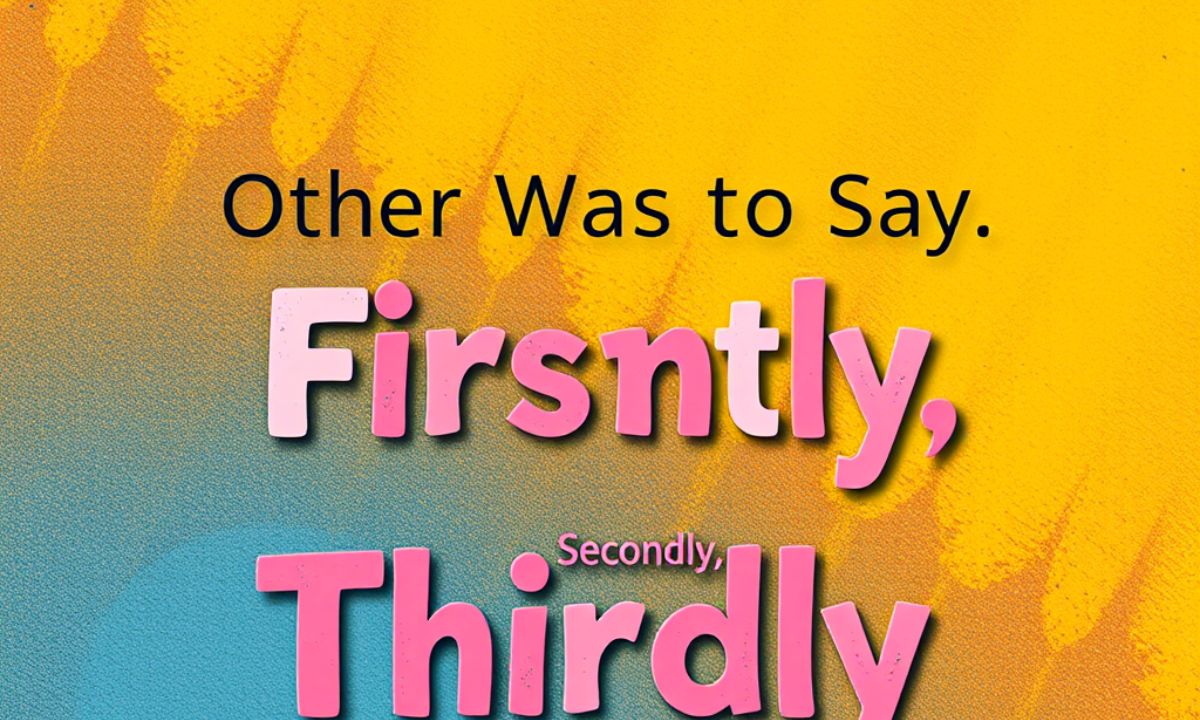It gets toneless and monotonous to write the same transitional phrases, such as firstly, secondly, thirdly
Searching for alternatives to such phrases enhances your content and keeps the reader alive.
Sophistication is maintained while organizing clearly one’s ideas through the use of these expressions.
Heightened flow and readability improve through the use of transition words. Learning such alternatives raises one’s writing skills in all types of communication..
READ MORE: https://travelloverage.com/say-i-believe-in-an-essay/
To Begin
The “To Begin” phrase is a modern substitute for the more traditional “firstly.” The expression serves as a point of departure for the argument, establishing the parameters of the discussion.
love the phrase for creating a conversational tone without breaking those formal structural guidelines.
When you say “To Begin,” it’s an indication to everyone following that some real information is forthcoming, as opposed to repeated phrasing.
Example: To begin our analysis of climate change solutions, we must examine current carbon emission levels worldwide.
Letter Sample
top: To begin my application for the marketing position, I would like to highlight my five years of industry experience.
Your company’s innovative approach to digital marketing perfectly aligns with my professional background and creative mindset.
I believe my skills in content creation and analytics would bring immediate value to your team.
To Start With
‘To Start With’ is a bit less formal, yet it invites an introduction to the first point. These expressions are equally applicable to academic writing and business.
The phrase provides a good segue into your main ideas and helps avoid the clichd ‘firstly.’ It marks your intention to take the reader on a logical pathway through your thoughts.
Example: To start with, economic implications of this policy will have to be addressed.
First
“First” provides a straightforward, concise alternative to “firstly” to signal the opening argument. A clear and effective way to start a sequence, this transition word manages without flourish.
Use “first” instead of “firstly,” and your writing will seem less formal and more natural-as-and-when. This simple substitute fits almost any context that requires sequential organization.
Example: Preheat the oven to 350 before you start preparing the batter.
Sample Letter Section:
First, I want to address the concerns you raised about our project timeline.
Our team has been working diligently to overcome the unexpected supply chain delays we encountered last month. We’ve implemented new tracking procedures to prevent similar issues in the future.
One Reason Is
“One reason is” changes the direction of the proof or justifies or explains something to support your argument; it ties the end point of the line to a cause instead of sequence.
It underlines weightiness-the point. It offers the best introduction of the many supporting features for one central claim.
One reason is an alternative that attracts but still keeps clear logical connections between ideas.
Example: One reason is that sustainable practices minimize costs for businesses in operations in the long run.
Sample Letter Section:
One reason is your resume stood out from those of other applicants vying for the software development position.
Your unique mix of technical know-how and leadership skills was a perfect match for what we were looking for in a team lead.
We believe that your innovative approach to problem-solving would enrich our developing department.
Following From That
This is the function of ‘following from that’: it links a thought that appears formulated or previously stated to the new entries.
This phrase defines succession in the thought stream and how the thoughts build one upon another. The result is the same for the whole writing, since it is the connecting point.
It is well used in analyses and arguments that need to show cause-effect relations.
Example: Following from that, we can conclude that increased investment in education leads to economic growth.
Sample Letter Section:
Following from that, we need to discuss the next steps for our partnership agreement.
As drafted, our legal team has put together a preliminary contract, including the terms we discussed in our last meeting.
Once you’ve had a chance to review the document, we can set up a follow-up call to address any questions.
After That
Specify the kinds of transitions that clearly signal the kind of shift involved and the time chronology with reference to the points or steps: “After That”.
Indeed, straightforwardness is the most effective transition in teaching or in the explanation of a process.
In fact, it remains completely free and provides an entirely natural flow to the reader while guiding him/her through an entire logical progression of ideas.
“After That” thus organizes the information very straightforwardly for the reader.
Example: After that, mix the wet ingredients with the dry ingredients until just combined.
Sample Letter Section:
After that unfortunate miscommunication related to the project specifications, our team immediately implemented new protocols requiring written confirmation of all client requirements before starting any work.
This change already improves our efficiency and accuracy in subsequent projects.
Second
“Second” stands as a straightforward alternative to “secondly” when a points-sustaining sequence is being introduced.
This transition, simple and to the fore, clearly indicates that some logical reasoning continues in motion. In fact, “second” gives off a more natural feel while “secondly” makes the writing feel a bit more mechanical.
The straightforward approach is workable at the same time in a formal or informal situation.
Example: Second, the environmental concern of this process of manufacture has to be taken into consideration.
The Next Reason Is
The next reason is providing for continued supportive arguments. This allows for better structural clarity while avoiding a repetitive use of the numbered transitions.
This phrase simply communicates that more justification for your side’s claim is at hand. Using this transition creates forward motion and builds momentum in persuasive writing.
Example: The next reason is that flexible working hours improve employee satisfaction and retention.
Sample Section of the Letter:
The next reason is that we believe your organization would stand to gain from our consulting services.
Our team’s specialized expertise in regulatory compliance has helped similar companies reduce liability risks by as much as 30%.
We have created a personalized approach that tackles the specific challenges that your industry faces.
Finally
Finally, I should appreciate your consideration of my application for this post.
I would definitely be willing to contribute to your fresh innovative works in renewable energy, something I have always wanted to pursue in my career.
I look forward to the possibility of discussing how my background in environmental engineering could have an impact on your upcoming projects.
Lastly
The term “lastly” presents the final item in a list of considerations, lending weight to the end.
It therefore completes a thought but does so in a more formal manner than the term “finally.”
By unlike the other linking words in this sequence, “lastly” tends to compel the reader into paying closer attention to the terminal idea.
As such, it is an unambiguous structural marker that helps in drawing attention to the finer details among several points in a complex discussion.
Example: Lastly, we should highlight some of the disadvantages that accompany this research method.
Third
“Third” indicates simply that another point has been made in what has come to be a three-point discussion or argument.
This is a plain transition that allows for clear awareness of the organization present within the discourse without bordering on the overly formal or repetitive.
The use of “third” allows the reader to follow along with the thought process put forward in a formal presentation. It may particularly suit a situation in which the organization of information is to be laid out plainly and directly.
Example: Third, we must consider the ethical implications of this medical procedure.
Sample Letter Section:
Third, I want to address your question about our company’s sustainability initiatives. We recently implemented a comprehensive recycling program that has reduced our waste by 35%.
Additionally, our transition to renewable energy sources for our manufacturing facilities demonstrates our commitment to environmental responsibility.
The Last Reason Is
“The Last Reason Is“: This offers a clear marker for the final piece of evidence put forth in support of your argument or explanation.
It accentuates the last justification and gives it a felt sense of importance. This transition signals to readers that they are reaching the end of the supporting evidence.
The effect is to prepare the audience nicely for your concluding remarks or call to action.
Example: The last reason is that diversifying our investments into more arrangements will show greater long-term financial security.
Sample letter section:
The last reason is that our proposal provides full training and continuous support for your staff. We know that new software systems take adjustment, so we provide technical help 24/7 for the first three months.
Our commitment to the success of our customers has yielded a 98% satisfaction rate from our clients.
Find More Words!
“Find More Words!” is a call to explore a few more linguistic alternatives besides the common transitions. It reminds writers of the need to broaden their vocabulary and expression options.
This would mean that good writers have a wide variety of transitional vocabulary to choose from. Creative transitions in writing serve as marks of sophistication and great attention to detail in your communication.
Example: Find more words to describe the benefits of the product instead of saying “excellent” over and over throughout the marketing copy.
Sample Letter Section:
Finding more words! That was my professor’s constant response to my early essays. This advice single-handedly transformed my writing from bland to interesting through an expansion of my vocabulary.
His recommendations taught me that, in language choice, exactness leads to better engagement.”
FAQs
Which of these alternatives is most suitable for formal academic writing?
“To begin with,” “Moreover,” “Then,” “To summarize,” and “Ultimately” would all suffice with regard to formality.
How can transitional phrases enhance my writing?
They allow smooth transitions from one idea to another, improving the ease of reading and demonstrating linguistic sophistication.
Does it mean that mixing different types of transitions in one document is acceptable?
Certainly; it is more interesting to read something that does not strictly adhere to one type of transition.
What is the most significant aspect of using other transitions?
Whether they are all appropriately connected in logic or not with the ideas, they keep the right tone for the audience and purpose as well.
Conclusion
They allow for a more natural flow of ideas and showcase a writer’s linguistic command. Using these transitions helps reduce redundancy while respectfully presenting a coherent organization.
These alternatives work in academic, professional, and creative settings to improve the effectiveness of communication.
A pervasive ability to use different transitional phrases indicates a level of writing that is regarded as advanced and is capable of style refinement.
Using these alternatives will help contribute to more stimulating pieces of work that keep the reader interested all the way through.
Keep in mind the purpose of transitions: to act as bridges between ideas so that the reader is able to smoothly ride along your logic as you put your thoughts together.
With practice, usage of these varied transitional options will become second nature.

I’m Irfan, an experienced SEO content and SEO specialist with 2 years of expertise, currently contributing to Al Jazeera News Website.












